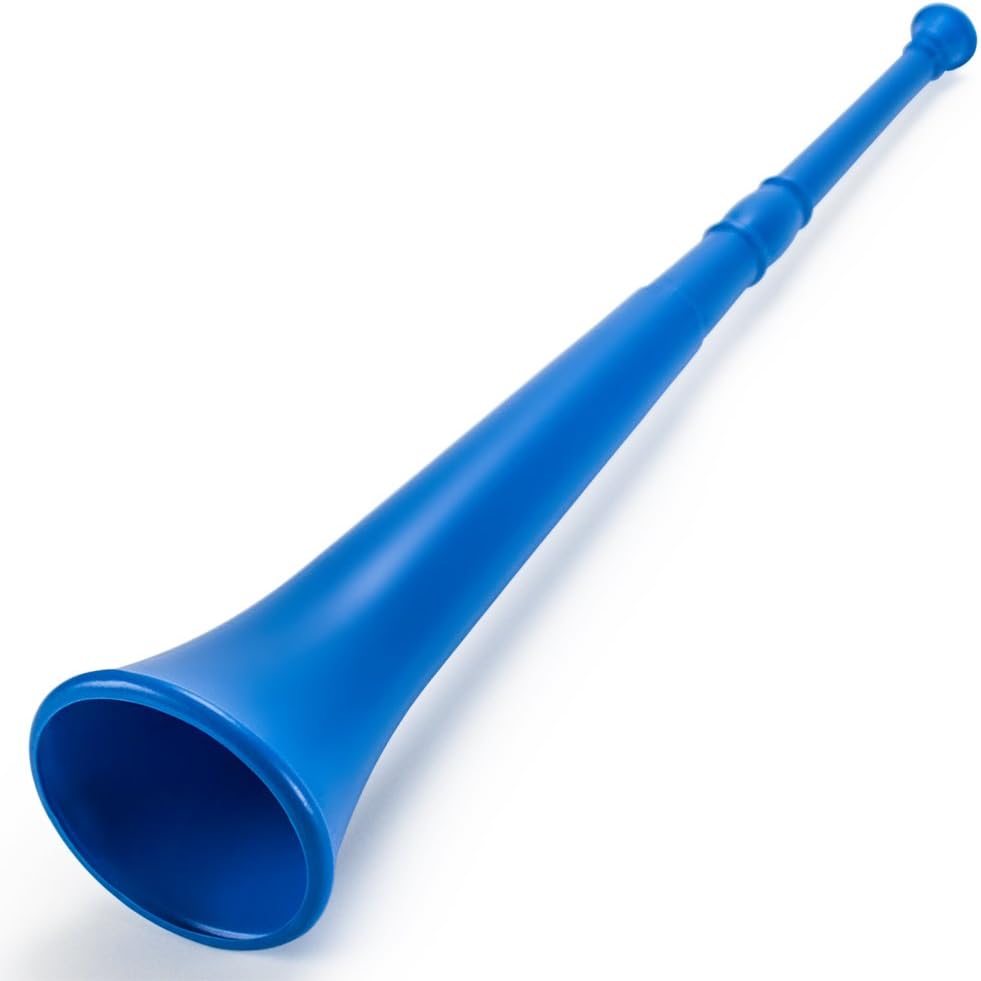Vuvuzela
Woodwinds
Africa
Between 1001 and 1900 AD
Video
The vuvuzela is a long, straight plastic horn known for its loud and powerful sound. It is widely recognized for its presence at football (soccer) matches, particularly during the 2010 FIFA World Cup in South Africa. The instrument is typically about 65 to 85 cm in length, though variations exist. It produces a monotone, buzzing sound that can reach high decibel levels, making it one of the most distinct and controversial instruments in modern sports and music culture.
The vuvuzela belongs to the brass instrument family, specifically classified as an aerophone. Aerophones produce sound through the vibration of air without the need for strings or membranes. While it is made of plastic, it shares similarities with traditional wind instruments that require the user to blow into them to create sound. The vuvuzela is a simple lip-reed instrument, meaning that the player must buzz their lips while blowing air through the mouthpiece to generate a tone.
History and Evolution
The vuvuzela, a long, plastic horn known for its loud and droning sound, has its roots in South Africa. While similar instruments existed in various cultures for centuries, the modern vuvuzela became widely recognized in the late 20th century. It gained global attention during the 2010 FIFA World Cup in South Africa, where it was used by fans to create an energetic atmosphere in stadiums. The instrument is believed to have been inspired by traditional African horns, such as the kudu horn, which was historically used to summon villagers. Though some sources suggest that early versions of the vuvuzela were made of tin, the plastic version became popular in the 1990s and was mass-produced by South African manufacturer Masincedane Sport. Despite controversy over its deafening noise levels, the vuvuzela remains a symbol of South African football culture and fan enthusiasm.
Construction
Modern vuvuzelas are typically made from plastic, which allows for mass production at low cost. Traditional versions were crafted from materials such as wood, horn, or metal, and these earlier iterations were often decorated with carvings or paintings. The design consists of a narrow mouthpiece that widens into a flared bell, similar to a trumpet. The simplicity of its construction makes it accessible and easy to manufacture in large quantities.
Types of Vuvuzelas
Although most vuvuzelas share a similar structure, variations exist in terms of length, material, and design. Some models are collapsible, allowing for easier transportation and storage. Others are designed with different textures or colors to reflect national pride, team spirit, or cultural identity. Some vuvuzelas are even customized with unique patterns or symbols to make them distinct among supporters.
Characteristics and Features
The vuvuzela is a long, straight, plastic horn, typically about 65 to 70 cm (26 to 28 inches) in length, though shorter versions also exist. It produces a loud, monotone sound when blown, reaching noise levels of up to 120 decibels, comparable to a jet engine. The instrument requires strong lung power to play, as the sound is created by blowing air through tightly pressed lips, similar to a brass instrument. Traditionally associated with South African football culture, the vuvuzela is often brightly colored and lightweight, making it easy to carry and use in stadiums. Its sound is powerful and continuous, often described as a buzzing or droning noise, which can be overwhelming in large crowds. Despite its simple design, the vuvuzela has a strong cultural significance and remains a symbol of enthusiasm and unity in sports events.
Sound Production
The sound of the vuvuzela is produced through lip vibration. When a player blows air through the narrow mouthpiece while buzzing their lips, the air column inside the instrument resonates, amplifying the sound through the flared bell. The pitch is primarily dependent on the player’s embouchure and air pressure rather than finger positioning or valves, as found in other wind instruments. This results in a largely unmodulated, monotone sound, often compared to an elephant’s trumpet or a swarm of bees.
Playing Methods
Playing the vuvuzela requires breath control and proper lip buzzing technique. Beginners often struggle to produce a clear sound at first, but with practice, they can maintain a steady tone. Unlike traditional brass instruments, the vuvuzela lacks a complex fingering system, making technique and endurance the primary focus of playing. Some skilled players can manipulate the intensity of their blowing to create rhythmic patterns or slight pitch variations, though these techniques are limited.
Roles in Music
Cultural Significance
The vuvuzela is deeply embedded in South African football culture and represents a form of national pride. During matches, it is used by fans to show support for their teams, create a sense of unity, and generate excitement in the stadium. Although its widespread use has sparked debates about its impact on the spectator experience, the vuvuzela remains a symbol of South African enthusiasm and identity. Beyond sports, it has also been used in protests, celebrations, and cultural gatherings, further cementing its role as a voice of the people.
The vuvuzela’s global recognition following the 2010 FIFA World Cup made it an enduring cultural phenomenon. Despite criticisms regarding its loudness and potential for disruption, it continues to be an iconic instrument that reflects the passion and energy of South African sports fans and their vibrant culture.
FAQ
What is the origin of the Vuvuzela?
The Vuvuzela originated in South Africa and became popular in football stadiums. It is believed to have roots in traditional African horn instruments used for communication and ceremonies.
What are the primary uses of the Vuvuzela?
The Vuvuzela is mainly used at football matches to create an energetic atmosphere. It is also used in celebrations, protests, and cultural events.
What role did the Vuvuzela play in the 2010 FIFA World Cup?
The Vuvuzela became a symbol of the 2010 FIFA World Cup in South Africa. Its loud buzzing sound added a unique and controversial sonic identity to the tournament.
 Links
Links
References
Other Instrument
Categories



















